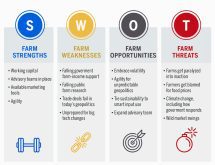When a television reporter recently tweeted a photo of a package of boneless, skinless chicken breasts in the meat department at Loblaws with a price tag of $37, the backlash was swift. The responses ranged from “eat less meat” to a less polite “let it rot on the shelf,” and they all had one thing in common: Canadians were angry about paying more for their food.
“I’ve been in this business for decades and I’ve never seen the amount of shifting of consumer patterns to this degree,” says Jo-Ann McArthur, president of Nourish Food Marketing in Toronto.
“Obviously, things have changed,” agrees Sylvain Charlebois, director of the Agri-Food Analytics lab at Dalhousie University.
Read Also

Farmland values: assumptions and realities
Where farmland values are headed and what decisions farmers should make
It’s been a jolt, Charlebois says. Among the big changes:
1. More food disappears
The higher prices that mean fewer Canadians can afford groceries also mean more are resorting to theft to put food on the table.
Walmart Canada told CTV News that the retail giant was experiencing “a historic uptick in theft” and Charlebois estimates that an average-sized food retailer could have up to $5,000 in groceries stolen per week.
On the positive side, inflation might help curb food waste. Canadians waste an average of 79 kilograms of food each year, according to a 2021 report.
While data on the impact of inflation on food waste isn’t available, Brenna Ellison, an associate professor in the department of agricultural economics at Purdue University in Indiana, participated in a webinar on the topic and said, “Historically, higher food prices are associated with less household waste because households want to better manage resources that cost more.”
McArthur agrees, adding, “Everybody’s hyper-focused on food waste … because that’s just money that you’re flushing down the drain.”
Inflation and rising food prices aren’t the only pressures Canadian food producers are facing, though. Charlebois points to avian flu, which had an impact on more than seven million birds and hundreds of flocks — extreme weather events, changing packaging requirements and more heterogeneous markets as other factors straining the food system.
“A lot of things are happening all at once,” he says. “Consumers have been quite demanding, wanting the safest food possible, the most environmentally friendly foods possible, the most local food possible (but) all of these things will come at a cost.”
Even producers receiving high prices for commodities that are in high demand have few options but to capitalize on the market, according to von Massow.
“Often farmers make more margins when prices are really good,” he says, “but that’s not happening as much as we might have expected with these higher prices because of the higher costs.”
2. Changing purchasing habits
A quick peek into Canadians’ shopping carts makes it clear that McArthur is right. A recent poll from the Angus Reed Institute found that four in five Canadian households are changing their menus to adjust for rising costs. Switching to cheaper store and private label brands was the most frequently cited strategy for slashing food budgets but 35 per cent of Canadians also cut back on meat and 21 per cent aware purchasing fewer fresh fruits and vegetables.
At the same time, sales of frozen foods have surged with some data showing that frozen foods exceeded fresh food sales by more than 230 per cent in 2022.
“Consumers are becoming smarter and more frugal at the same time,” Charlebois says. “They’re budgeting, they’re looking at apps, and in the store they’re trading down or trading sideways, compromising on proteins or with dried goods.”
3. Less resistance to GMO
Canadians spent more than $8 billion on organic products in 2021, according to the Canada Organic Trade Association. As food prices rise, though, their willingness to pay the price is going down.
Due to tight budgets, shoppers who prefer organic food fell from 15 per cent to 10 per cent. Dairy Farmers of Ontario announced a decrease in organic milk production allocation from August to December 2022.
Similarly, the percentage of adults who prefer to purchase non-GMO foods also decreased, declining almost 40 per cent.
“As those prices go up and stay up, we will see people go back to the ‘base model’ of some of those food products,” says Michael von Massow, food economist and associate professor in the Ontario Agricultural College at the University of Guelph.
But, adds von Massow, “I think, without a doubt, (those changes will be) temporary.”
McArthur is watching. “The overall trend to more sustainable agriculture is there (but) it’s going to take more time in a high inflation market,” she says. “We need an industry solution for transitioning, some kind of bridge financing model, to help farmers transition to more sustainable agriculture in the high-interest environment.”
4. Fluctuating food supplies?
Canadian interest rates are the highest in three decades and farmers are struggling with higher input costs. Unlike grocers and food manufacturers who raise their prices and pass their cost increases on to consumers, farmers typically have to absorb the pain.
“If you look at the whole food chain … who’s benefiting the least or being hurt the most in a high inflation environment, it’s the farmers,” says McArthur.
In the U.S. and abroad, it appears farmers are scaling back production to adjust to high inflation, rising costs, fertilizer shortages and changing consumer purchasing habits.
It’s unclear whether Canadian farmers will follow suit.
















